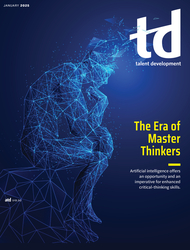TD Magazine Article
New Year, New Company
Data suggests many workers may leave their companies in 2025.
Wed Jan 01 2025

Fifty-six percent of employees will look for new jobs in 2025, according to an article, "6 in 10 Workers Eye New Jobs in 2025," from ResumeTemplates.com. The company surveyed more than 1,200 full-time US workers to discover that one out of three individuals plan to quit even if they don't have another job.
The Eagle Hill Consulting Employee Retention Index reveals that worker attitudes regarding workplace culture declined by 2.3 points at the end of 2024. That statistic mostly represents Generation Z and women because, as Eagle Hill found, those two groups are the most likely to leave a job due to cultural issues.
"Employers who want to retain female and Gen Z workers should consider doubling down on engaging with those employees because our data indicates they are most at risk of leaving," says Melissa Jezior, consulting president and CEO of Eagle Hill, in a press release. "That means digging in to understand the unique needs and preferences of these employees and taking any needed action to meet them where they are. For example, women and Gen Z employees often place a high value on workplace culture, flexibility, career development, and feeling connected to their work."
ResumeTemplates.com notes that work-life balance, compensation, and job security are all top priorities for job seekers. Concerns that cause individuals to seek employment elsewhere include feeling undervalued, experiencing burnout, limited growth opportunities, poor management, unsatisfactory benefits, and a lack of flexibility, the latter of which ties directly to return-to-office mandates. For example, the Conference Board's The Reimagined Workplace 2024 study of US HR executives found that 45 percent of organizations with mandatory on-site requirements have had issues with retention.
The good news, Jezior notes, is that an upward-trending economy represents an opportunity for companies to focus on strategic initiatives.
"With a robust economy and stable workforce, employers can take the long view on strategic priorities and even tackle issues that are more difficult to address—from operational efficiencies to reorganizations," she says.
You've Reached ATD Member-only Content
Become an ATD member to continue
Already a member?Sign In

